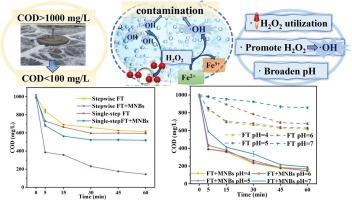High-efficiency treatment of lead-zinc beneficiation wastewater by Fenton (FT) coupled with micro-nano bubbles (MNBs): effective utilization of H2O2
IF 5
2区 工程技术
Q1 ENGINEERING, CHEMICAL
引用次数: 0
Abstract
Mineral processing wastewater residues large amounts of organic flotation reagents (xanthate and No. 2 oil), posing environmental and health risks. Traditional Fenton (FT) methods face limitations like acidic pH dependence, low efficiency, and reagent waste. This study first introduces a stepwise FT process coupled with micro-nano bubbles (MNBs) to enhance treatment efficiency of difficult-to-degrade lead–zinc beneficiation wastewater. The MNBs-assisted system achieved 85.43 % COD (chemical oxygen demand) removal in 60 min, while only 38.54 % was achieved without MNBs, and extended pH applicability to neutral. With thermal activation, COD decreased from 1008.00 to 96.65 mg/L, which meeting GB25466 − 2010 discharge limit and achieving 90.3 % degradation. MNBs significantly improved H2O2 utilization, demonstrating industrial potential.

Fenton (FT) -微纳气泡(MNBs)高效处理铅锌选矿废水:H2O2的有效利用
矿物加工废水中残留大量有机浮选剂(黄药和2号油),构成环境和健康风险。传统的Fenton (FT)方法存在酸性pH依赖性、效率低和试剂浪费等局限性。为了提高难降解铅锌选矿废水的处理效率,本研究首先引入了微纳气泡(MNBs)耦合的步进FT工艺。MNBs辅助系统在60 min内COD去除率达到85.43%,而在没有MNBs的情况下COD去除率仅为38.54%,并且将pH值的适用性扩展到中性。经热活化后,COD由1008.00 mg/L降至96.65 mg/L,达到GB25466 ~ 2010排放限值,降解率达到90.3%。MNBs显著提高H2O2利用率,具有产业化潜力。
本文章由计算机程序翻译,如有差异,请以英文原文为准。
求助全文
约1分钟内获得全文
求助全文
来源期刊

Minerals Engineering
工程技术-工程:化工
CiteScore
8.70
自引率
18.80%
发文量
519
审稿时长
81 days
期刊介绍:
The purpose of the journal is to provide for the rapid publication of topical papers featuring the latest developments in the allied fields of mineral processing and extractive metallurgy. Its wide ranging coverage of research and practical (operating) topics includes physical separation methods, such as comminution, flotation concentration and dewatering, chemical methods such as bio-, hydro-, and electro-metallurgy, analytical techniques, process control, simulation and instrumentation, and mineralogical aspects of processing. Environmental issues, particularly those pertaining to sustainable development, will also be strongly covered.
 求助内容:
求助内容: 应助结果提醒方式:
应助结果提醒方式:


